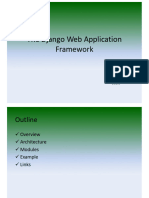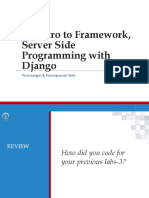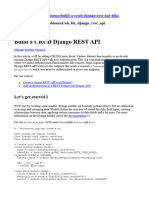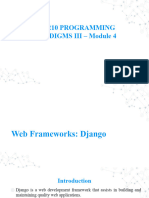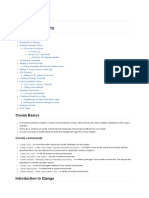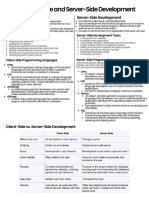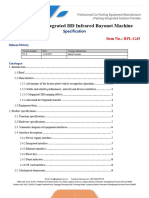Django
Tags
Fundamentals
A batteries included framework: it comes with a lot of features.
Admin interface
Object-relational Mapper
Authentication package
Data for Caching data
we can give API end points on the server to get the data
Setup
install python from browser
First project
pipenv install django
the command django-admin lists out all possible comands
djangoadmin startproject creates a project
Dynamic web content:
suggested reading : introduction to networking
Django 1
� the browser makes a socket connection to the server and then requests
something from the server. The server sends out information ( htmsl / json or
anything else) what the browser recieve is usually what ends up as a display
page.
Network sockets
http: invented n the 1990
Request for Comments
the client makes the first move.
sockets are like phone calls
Building a small browser in python
Creating new Django project:
django-admin startproject my_tennis_club
python -m Django gives the list of commands
views are used to customize what we see on the webpage .
we send out html tags to the browser and the browser renders this html.
http response is a class that helps us turn text into html
handling URL routes
Django 2
� the views file can contain all views we define
from django.http import HttpResponse
HTML_STRING ="""
<h1>Hello world</h1>
"""
def home_view(request):
return HttpResponse(HTML_STRING)
in the urls.py define new url paths
from . import views
urlpatterns = [
path('',views.home_view),
path('admin/', admin.site.urls),
]
Customising the view
create a views.py file in the project folder
Django has http response
from django.http import HttpResponse
Adding Data to views
we can add data with variables in the html string
Django 3
� 💡 startapp:
creating a piece of the current django project
Models:
Reference
creting database models
# Create your models here.
class Article (models.Model):
Title = models.TextField()
content = models.TextField()
all models in django will inherit from models.Models
when we create and edit models, we should let django know about these actions.
Migrations are run to do that
Migrations
python manage.py makemigrations
python manage.py migrate
Writing and reading data
trying out the logic with the cli
Django 4
� Doing it with code:
article_obj=Article.objects.get(id=2)
HTML_STRING =f"""
<h1>{article_obj.Title}</h1>
<p> {article_obj.content}</p>
"""
def home_view(request):
return HttpResponse(HTML_STRING)
Django templates
templates can be added as html files.
template configuration in the settings.py, add the directory to the ‘DIRS’
the html file can be rendered to a string with django’s inbuild feature.
Django 5
� from django.template.loader import render_to_string
Inheritance template:
templates can inherit from other templates .
below is a base html file
<!DOCTYPE html>
<html lang="en">
<head>
<meta charset="UTF-8">
<meta name="viewport" content="width=device-width, initial-scale=1.0">
<title>Document</title>
</head>
<body>
<h1>Title from base</h1>
{% block content %}
<h3>placebolder</h3>
{% endblock content %}
</body>
</html>
the block content is what gets replaced by the templates that inherit from this
base template
The child inheriting would look like this:
{% extends "base.html" %} //for inheritance
Django 6
� {% block content %}
<h1>{{ title }} </h1>
<p> {{ content }}</p>
{% endblock content %}
Taking elements from database
we can take out the data (objects) from out database and render it to the views
article_queryset= Article.objects.all()
the above code takes out all the objects of Article and gives us the list.
to render this we can pass the object as an element in the context and call it in the
view
{% for x in object_list %}
<li>
<a href="articles/{{x.id}}">{{x.Title}} </a></li>
{% endfor %}
for loops and any other logical statements can be performed within the template
note that the loops are ended
if will also be ended by an endif.
Django 7
� Dynamic Routing
Context processors
Deplaying Apps:
Django rest framework
Serializers :
In DRF, serializers convert Django model instances into JSON format and vice
versa.
views while using apiView
from rest_framework.views import APIView
from rest_framework.response import Response
from rest_framework import status
from core.models import Solution, Question, Grade, Subject, Chapter, Category,B
Django 8
� from django.shortcuts import get_object_or_404
from .serializers import SolutionSerializer, QuestionSerializer, GradeSerializer, Su
# Generic CRUD View
class CRUDView(APIView):
model = None
serializer_class = None
def get(self, request):
"""Retrieve all instances"""
instances = self.model.objects.all()
serializer = self.serializer_class(instances, many=True)
return Response(serializer.data, status=status.HTTP_200_OK)
def post(self, request):
"""Create a new instance"""
serializer = self.serializer_class(data=request.data)
if serializer.is_valid():
serializer.save()
return Response(serializer.data, status=status.HTTP_201_CREATED)
return Response(serializer.errors, status=status.HTTP_400_BAD_REQUEST)
class CRUDDetailView(APIView):
model = None
serializer_class = None
def get(self, request, pk):
"""Retrieve a specific instance"""
instance = get_object_or_404(self.model, pk=pk)
serializer = self.serializer_class(instance)
return Response(serializer.data, status=status.HTTP_200_OK)
def put(self, request, pk):
"""Update an instance"""
instance = get_object_or_404(self.model, pk=pk)
Django 9
� serializer = self.serializer_class(instance, data=request.data, partial=True)
if serializer.is_valid():
serializer.save()
return Response(serializer.data, status=status.HTTP_200_OK)
return Response(serializer.errors, status=status.HTTP_400_BAD_REQUEST)
def delete(self, request, pk):
"""Delete an instance"""
instance = get_object_or_404(self.model, pk=pk)
instance.delete()
return Response({"message": "Deleted successfully"}, status=status.HTTP_
# Creating views for each model by inheriting CRUDView and CRUDDetailView
class SolutionListCreateView(CRUDView):
model = Solution
serializer_class = SolutionSerializer
class SolutionDetailView(CRUDDetailView):
model = Solution
serializer_class = SolutionSerializer
class QuestionListCreateView(CRUDView):
model = Question
serializer_class = QuestionSerializer
class QuestionDetailView(CRUDDetailView):
model = Question
serializer_class = QuestionSerializer
class GradeListCreateView(CRUDView):
model = Grade
serializer_class = GradeSerializer
class GradeDetailView(CRUDDetailView):
model = Grade
serializer_class = GradeSerializer
Django 10
� class SubjectListCreateView(CRUDView):
model = Subject
serializer_class = SubjectSerializer
class SubjectDetailView(CRUDDetailView):
model = Subject
serializer_class = SubjectSerializer
class ChapterListCreateView(CRUDView):
model = Chapter
serializer_class = ChapterSerializer
class ChapterDetailView(CRUDDetailView):
model = Chapter
serializer_class = ChapterSerializer
class BoardListCreateView(CRUDView):
model=Board
serializer_class = BoardSerializer
class BoardDetailView(CRUDDetailView):
model = Board
serializer_class = BoardSerializer
Django 11
